The Illustrated London News and Military Technology of the Great War
Andrew IarocciCanadian War Museum in Ottawa
1 In the 21st century we can view images of conflict on television or the internet at any hour of the day, nearly anywhere in the world, almost in real time. In the late-19th and early-20th centuries, illustrated periodicals “showed” the public what war looked like. Upon the outbreak of the First World War in 1914, The Illustrated London News (ILN) was a well-established weekly in print for more than seventy years.1 Wartime issues of the News typically included a full complement of illustrations from the previous two to three weeks. Approximately ninety per cent of these images concerned military affairs, either at the combat fronts or on the home fronts of the belligerents. The few images not depicting military or war-related activities are found in some of the advertisements, or perhaps the occasional women’s fashion column. Coverage of the British Empire and French armies was a staple, although editors also devoted considerable attention to the Russian forces, as well as smaller allies such as Serbia, Italy, Portugal and Romania. From a home front perspective, illustrations of women engaged in munitions work were common. Photographs and illustrations of German and Austro-Hungarian troops were also widely published, although enemy figures tended to play supporting roles in images of the Allied forces.
A War of Technology
2 From the smallest piece of kit to the new twenty-eight-ton tanks of 1916, wartime illustrations in ILN bristled with weapons and machines. In addition to photographs, sketches and paintings, regular columns in each issue revolved around technology. One such column, Science Jottings, reflected on a broad range of discoveries in the fields of science and natural history; Chronicle of the Car, examined early developments in the automotive industry, including civil and military applications for the latest vehicles and engines. Most striking, however, are the visual depictions of technology in battlefield scenarios, especially the large format sketches and panoramic illustrations. Not only do these images show us how the war experience was packaged and delivered to the public, they also preserve an eclectic variety of inventions, innovations and techniques which may otherwise have been lost to memory. In many cases, trench warfare gadgets were one-of-a-kind objects improvised by ordinary soldiers at the local level, to be experimented with and perhaps quickly forgotten—or ultimately mass-produced for general issue to entire armies. In either case, ILN reveals something of the roles of military objects in trench warfare—from the quotidian to the bizarre.
3 As journalism professor Michèle Martin (2006) explains in her recent study of illustrated periodicals in wartime, scholars have approached these sources with widely varied methodologies. B. E. Maidment (1996), an expert in the field of popular literature, contends that periodicals like The Illustrated London News ought not be interpreted as direct reflections or “snapshots” of their historical time and place, but examined as discursive texts, consciously tailored by their authors to transmit a particular ideal. Other scholars, such as Peter W. Sinnema (1998), contend that illustrations and their captions must be analyzed separately, since some “readers” were totally illiterate, while others could not read well enough to make sense of the captions. For the literate audience, an illustration might have a much different impact than for those who could only make sense of the pictures in isolation from captions (Martin: 48-50).
4 This review explores the depiction of military technological objects on or near the battlefields of 1914-1916—a phase of innovation and improvisation. Informed by my research background in the operational and material history of the First World War, I have classified images under two broad categories. The first includes illustrations of technology that seem to imply some degree of continuity with the past, rather than a radical departure with pre-war norms (“time-bridging” images). The second group seems to underscore superficial similarities between soldiering at the front and ordinary civilian-living at home (“space-bridging” images). Whether the artists and photographers who sold images to ILN actually intended to link their work with the past, or establish a sense of shared experience between combatants and civilians cannot be established with certainty. Typically it was the caption writer’s words that explicitly grounded a given image in past experience or identified common threads between the otherwise distinct military and civilian spheres. In either case, the categories I have developed are based on my own interpretation of the images and text. There is no concrete evidence that management or editorial staff members at ILN intentionally tailored their product to achieve the ends I have suggested. Nor is it possible to gauge the response of readers with any certainty. Yet, given the recurring themes and patterns in the illustrations and captions, it is possible to at least speculate about their overall design, as well as how they might have been interpreted by contemporary readers.
5 It is especially remarkable that most illustrations from both categories (time-bridging and space-bridging) are starkly realistic, at least within the bounds prescribed by wartime censors. Artists juxtaposed highly detailed representations of technology against a backdrop of violence and destruction. As such, their illustrations reflected the technological calculus of warfare: how inventors and combatants designed and employed tools to overcome challenges in a broad range of tactical, operational, climatic and geographic situations. In this regard, the images can usefully supplement historical research in the fields of combat operations, military innovation and everyday army life for soldiers.
Fig. 1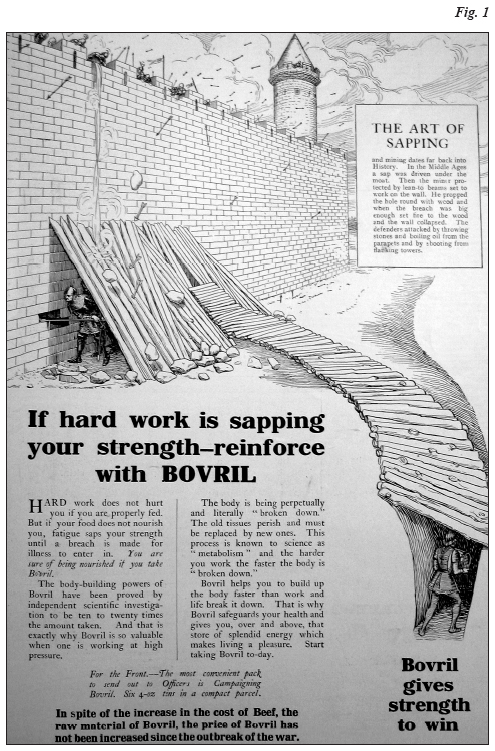
Display large image of Figure 1
6 Because much of the new or revised technology employed during the war was fielded as of 1915 or 1916, my larger sampling pool is limited to issues published from the outbreak of war through to the end of 1916, approximately 120 issues in total. Even for this two-year period, the volume of material makes it impossible to account for every technologically relevant illustration, or even every issue. That being the case, I have attempted to include a chronologically balanced selection covering land and air operations during the 1914-1916 period, basing choices on several more particular criteria.2 The first criterion is the technical quality of the original illustration. Photographs tended to be reproduced in small format, often with poor contrast. Sketches and paintings, on the other hand, were usually printed across one or two full pages, with sharper resolution and more clearly visible detail. Moreover, the illustrator or artist was able to recreate images of combat that were difficult, if not impossible for photographers to capture, because of the complexity of early photographic equipment and the obvious dangers involved with front line photography. Consequently, my selection favours paintings and sketches over photographs. An additional factor influencing the selection process was the relative novelty of items pictured in illustrations and commented upon in the captions. For the 1915 period, steel helmets and camouflage accessories are two such examples. In other instances, such as a French soldier making a votive offering of captured equipment in a ruined church, I have included an image because of some obvious incongruity—in this case, a soldier who has carried arms into a holy place.
Bridging Time
7 Cultural and military historians alike describe the war as a time of transition on and off the battlefield. There is clear evidence of the transformative process in the wartime issues of The Illustrated London News; the generous space that editors devoted to new military devices and techniques highlighted the evolution of fighting a war. At the same time, the illustrations, captions, articles and even the advertisements in the paper tended to invoke historical precedent—real or imagined—at least as much as they looked to future possibilities. A Pears’ Soap advertisement under the heading “Links in Britain’s Chain of War” (ILN, 22 January 1916) reminded consumers that the brand’s military heritage dated back to Napoleonic days. In a large format ad, Bovril asked readers if work was “sapping” their strength. An accompanying illustration shows medieval sappers at work under the walls of a castle (Fig.1). According to the ad copy, “the art of sapping and mining dates far back in to history…” (18 November 1916). Few readers, however, would have missed the connection between the sapping pun and contemporary field engineering on the Western Front, where small groups of specialists (still called sappers in the Royal Engineers) excavated tunnels beneath enemy positions. Indirectly, then, the Bovril ad may have suggested to readers that troglodyte warfare on the Western Front, while horrific and ungentlemanly, was not really unprecedented.
Fig. 2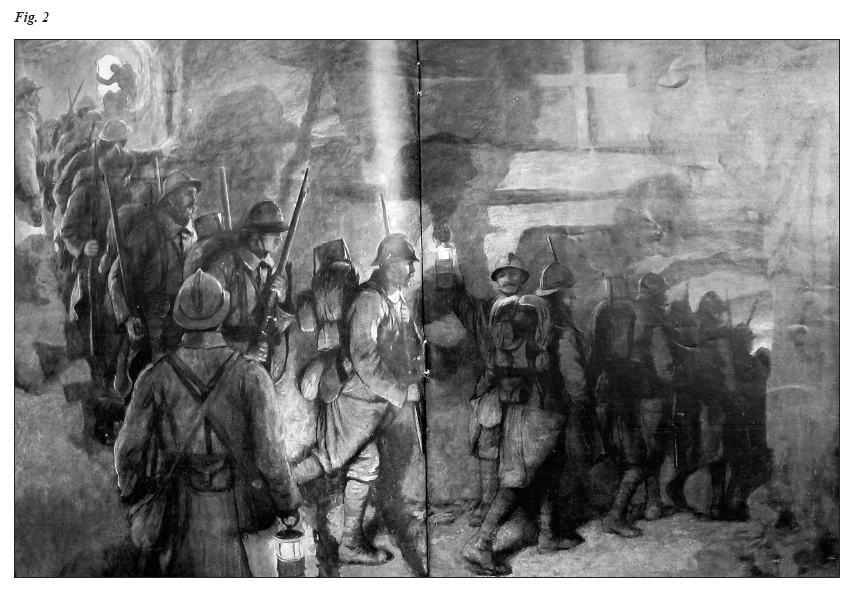
Display large image of Figure 2
8 Historical references common in advertisements were just as prominent in paintings, sketches and photographs featured in ILN. In a two-page illustration (4 March 1916), by veteran war artist Frederic Villiers we see a column of French soldiers filing in to a deep underground shelter (Fig. 2). The caption reflects on similarities with “medieval” warfare:At a hasty first glance, the helmeted figures here seen might be taken for infantry men-at-arms of olden times entering by the customary underground passage under the battlements from a sally-port in the moat of some medieval castle, on their return from a raiding foray among the enemy…. The representation on the walls of the passage of a prominently displayed cross adds a further medieval touch to the scene depicted.As the caption implies, it is the objects in this particular illustration—the helmets and cross in particular—that linked 1916 with an imagined medieval past, suggesting a precedent for siege warfare on the Western Front.
9 It was true that many of the most important items to appear on the battlefields of the Great War were actually ancient objects that had fallen out of use during the wars of the 18th and 19th centuries. The steel helmet, which first reappeared in the French Army in 1915, is an obvious example of an old technology dusted off for trench warfare applications. The early helmets of 1915 were little more than simple metal skull caps worn over top of the traditional kepi rouge; only later in the year did the French begin mass production of the ubiquitous casque Adrian—the type of helmet shown in Villiers’ ILN sketch (4 March 1916)—with its prominent comb and Sherlock Holmes-style brim for and aft. A detailed portrait of three French infantry assault troops equipped with the latest battle gear and weapons—steel skull protectors, respirators, grenades (bombs) and body armour—invoked a less specific ancient past (Fig. 3). The caption that accompanies ILN (7 August 1915) illustration reads: Armoured and Armed: Twentieth Century Infantry Equipped in Both Ancient and Modern Manner: Features of the war which have attracted universal surprise and attention have been the way in which long obsolete battle weapons and defensive armour have been again resorted to. We have dealt with the developments in these pages … showing hand-grenades, catapults, steel caps, shields, old-type mortars, etc, as each made its appearance, ever since they first began to be used last autumn during the trench warfare on the Aisne....As with Villiers’ sketch of the underground shelter, this illustration draws an obvious parallel between warfare from long ago and the trench fighting along the Aisne River in the aftermath of the inconclusive mobile operations of August-September 1914.
Fig. 3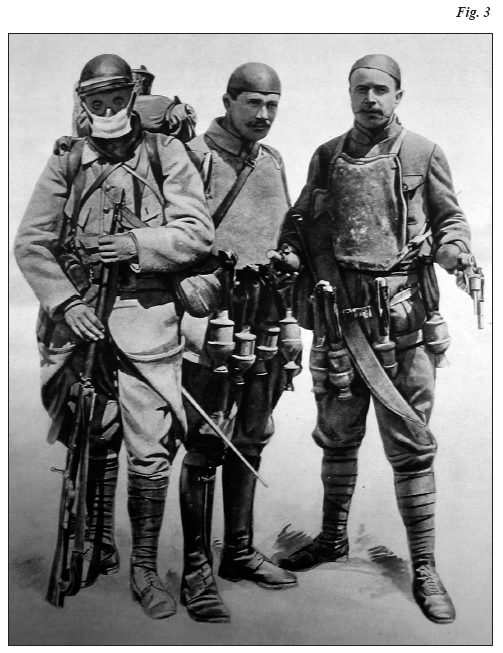
Display large image of Figure 3
10 In the cases of ballistic helmets and body armour, it was not much of a stretch to associate the new gear with earlier ages of warfare, but the paper drew similar connections for other less likely items. After the Fourth German Army introduced chlorine gas to the Western Front in April 1915, images of protective gear were commonplace. While there was little historical precedent for the ensuing chemical arms race, the texts attached to gas-related illustrations still managed to draw connections with the distant past. In a late 1915 issue (11 December 1915), the caption for a large format profile view of a British soldier dressed in a ghoulish-looking gas helmet and waterproof cape (Fig. 4) underscored the paradoxical intersection of the old-fashioned and the modern.One of the strangest results of the war has been its effect on the appearance of the fighting man, when equipped in full scientific panoply. Thus we have seen the reversion to helmets, the use of skin-coats in winter, and the bomber’s novel outfit. But the weirdest effect of all is that produced by wearing of anti-gas respirators, which make the soldier look like a Familiar of the Spanish Inquisition, with pointed hood and sinister eye-pieces….Upon first consideration, the horrors of chemical warfare probably did not evoke images of the Spanish Inquisition; yet, in this instance the connection was made through the objects themselves, rather than the context of their employment.
11 Most of the prominent modern weapons systems employed in the First World War—aircraft, machine guns, submarines and armoured cars—were already in use before 1914. The tank, which first appeared on the shattered Somme battlefield in September 1916, was an exception. As cultural historian Patrick Wright has shown, this new weapon captured public imagination and held on throughout the 20th century. As an iconic object, we still closely associate tanks with some of the most notable media moments of the last century: the Blitzkrieg of 1939-40, Prague in 1968 and Tiananmen Square in 1989 are key examples (Wright 2000). The problem for The Illustrated London News and other periodicals in September 1916 was that security-conscious War Office censors prohibited the publication of realistic tank illustrations until late November, more than two months after the machines’ operational debut. As a stopgap alternative, ILN again turned to the past, reproducing a series of sketches (21 October 1916) depicting what supposedly represented “Tanks of the Other Days: Old Time ‘Forts’ on Wheels” (Fig. 5).3 These included a Tudor war cart, Cowan’s Locomotive Land Battery of 1855 (after a drawing from the Patent Office), the Kaiser’s 1897 Battle Line Breaker and a series of other bizarre contraptions that probably never existed beyond the realm of an inventor’s imagination (21 October 1916). Finally, in the November 25, 1916, issue, the first photograph of a real tank appeared, a Mark I equipped with six-pounder guns, which identified it as a “male”; “female” tanks were outfitted with machine guns rather than light artillery (Fig. 6). The caption for this image reaches beyond concrete historical foundations to the mythological past:Hitherto the celebrated tanks have been almost as mythical as the various mythical monsters—Leviathan, Behemoth and so on—to which they have been so lavishly compared … the tanks have been described as able to knock down houses and trees, and crawl over trenches and shell-craters, spitting fire, and impervious to anything but a direct hit from a big shell….The reality was somewhat different, as the awkward machines could barely manage speeds of one or two miles per hour across a shell-scarred battlefield, with most breaking down before they were able to engage the enemy.4 Such inconvenient realities did not prevent illustrators from constructing their own epic versions of how the machines looked in action. A painting by Alfred Pearse, commissioned by King George, appeared across two pages in the December 2, 1916, issue. The brief caption has little to say about the intricacies of armour tactics, but the illustration features a sort of Old Testament biblical style: the tank lumbers forward, surrounded by swarms of British infantry, physically crushing the terror-stricken German soldiers who are struggling to escape its path (Fig. 7)
Fig. 4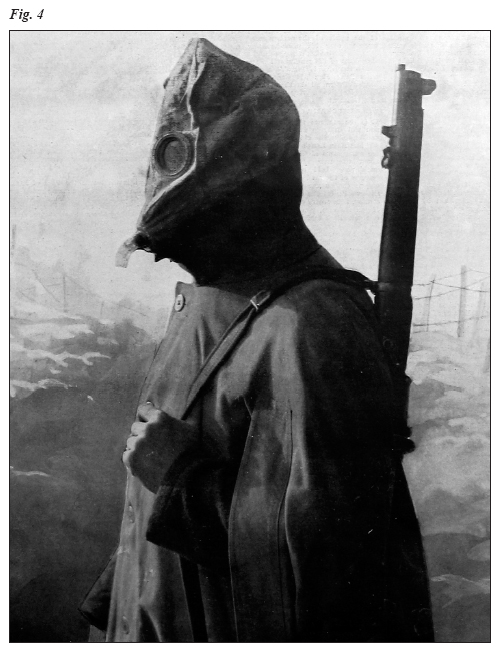
Display large image of Figure 4
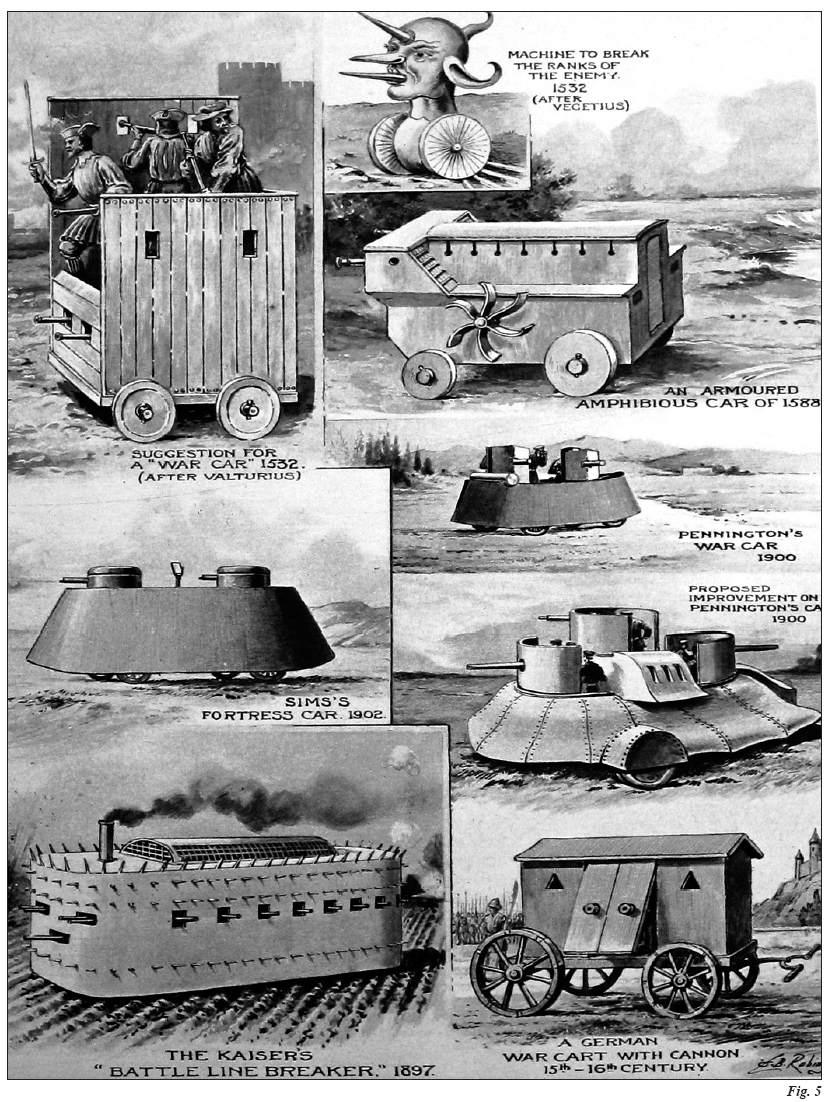
Display large image of Figure 5

Display large image of Figure 6

Display large image of Figure 7
12 Did the Great War have much in common with the conflicts of medieval or ancient times? For the illustrators and caption-writers of The Illustrated London News the relationship was a function of weapons, equipment and the general appearance of soldiers. Were the similarities superficial? Probably so, and this explains why the comparisons tended to be vague; comparing 1915 and 1916 with the “ancient” and “medieval” periods was hardly very specific. It was less common to make an exact comparison with a specific historical event, as seen with the parallel between the British gas helmet and the hoods of the Spanish Familiars. It is perhaps more instructive to ask why the past was so often invoked in ILN’s wartime illustrations, especially since, in hindsight, we tend to remember the Great War as a crucible of modernity and transformation. Although static fighting on the Western Front was not without recent precedent, the protracted violence and blood loss in France and Flanders was unfamiliar to the generation of 1914. It may be that vague comparisons between contemporary experience and hazy memories of older styles of warfare offered some degree of reassurance to readers at home, and possibly even soldiers at the front. A sense of continuity might have offset misgivings that accompanied long casualty lists and indecisive offensives. Audoin-Rouzeau and Becker of l’Historial de la Grand Guerre, at Péronne, suggest that too many military historians have yet to confront the violence of the war in truly explicit terms (2002: 14-18). Perhaps this tendency is rooted in wartime illustrations and photographs that depict the implements of war with perfect realism, but divert attention from unpleasant realities by steering readers’ imaginations toward the distant past, in effect transplanting 20th-century war paraphernalia into a completely different context.
Bridging Space
13 Within this second category there are at least three explicit illustration styles to consider more specifically. The first type offers the reader an almost-like-being-there combatant’s perspective. A particularly striking example from late 1915 shows the view of a Royal Flying Corps observer/air gunner over the sights of his Lewis gun as bullets are fired at a German Albatross off in the distance (Fig. 8). The painting is by war artist A. Fortescue, but as the caption explains, it was based on a “sketch from an officer who took part in the fight…” (13 November 1915). Readers are thus shown exactly what the officer is alleged to have seen in aerial combat. The technical details are highly realistic:Expended cartridge cases are seen dropping in a rapid stream from the ejector pipe beneath, as fast as the shots are fired. The gunner’s right hand, below, manipulates the trigger grip; his left hand, above, holds the spade grip, controlling the piece and its aim. Below is seen a spare drum, ready for fixing in place.Another such example from early 1916 puts the reader behind a British .303 Vickers machine gun, with a clear view of the enemy’s parapet across no-man’s-land (Fig. 9). The caption is worth citing in full:The rear-sight of a machine-gun, with its elevating-screw, graduated scale, and notched aiming bar, is shown as the man firing the gun sees it—the mechanism being drawn larger than life-size, as an aid to clearness. The gunner is taking aim at an enemy’s trench from within a covered embrasure, and is ready to fire through the loophole. His sights are laid on the point at which a howitzer high-explosive shell (fired from in rear of the machine-gun position) is seen bursting, the gunner intending to pour a shower of bullets among the trench-defenders as they become suddenly exposed to view through the gap in the trench-parapet made by the shell-burst. A machine-gunner often gets on such occasions an exceptional opportunity for dealing effective execution. The officer who sent us the sketch from which our drawing was made gave it the title, “Seeing the Sights.” (29 January 1916)5The caption, in this instance, surpasses even the aircraft example in degree of technical detail. The caption writer carefully describes the workings of the machine gun and the tactical principle being employed (cooperation between artillery and machine guns), making quite clear that the sketch is intended to show the reader the battlefield as “the man firing the gun sees it….” It is difficult to find a style of didactic illustration making more explicit use of a realistically sketched object to transport readers from their armchairs to the battlefield or the skies above it. Both sketches (Figs. 8 and 9) make clear that a distant enemy is being destroyed by machine gun or artillery fire. Yet, in each instance the artist’s emphasis on the weapons, rather than their targets, avoids the human consequences of technologically-driven violence.
Fig. 8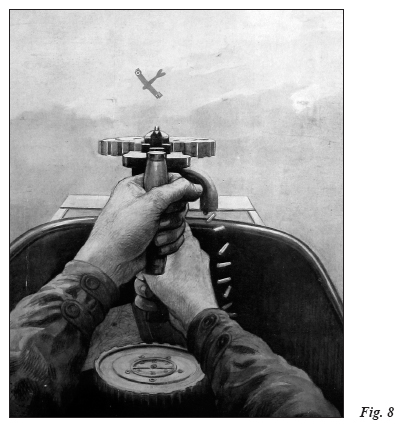
Display large image of Figure 8
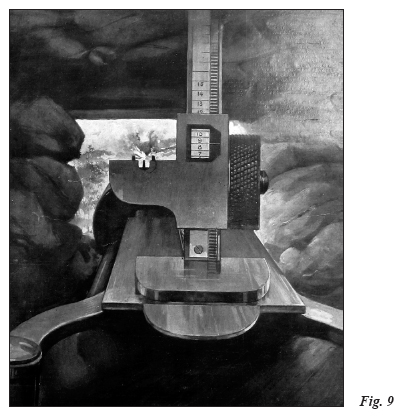
Display large image of Figure 9
14 A second category of space-bridging illustration seems to draw upon technology to identify the soldier’s experience of war with everyday civil life. A common example is the use of London city motor buses as troop transport vehicles near the front lines (Fig. 10). The caption beneath an illustration of these vehicles that appeared in the February 20, 1915, issue of ILN explains:When Kipling wrote “There ain’t no ‘buses runin’ from the Bank to Mandalay” he could not have anticipated the present Great War, when, metaphorically, ‘buses are running from the Bank, if not to Mandalay, at least to many places at the front. The London motor-‘bus, indeed, is a feature of the war zone, carrying rations, reinforcing troops, and wounded. It has done fine work, very often with a driver much more familiar with London streets than with the highways and byways across the channel....Along the same lines, it is common to find illustrations of soldiers performing ordinary domestic tasks at the front: sewing, cooking, cleaning and so forth. The issue of August 12, 1916, included a series of photographs of British soldiers under the headline: “The Domestic Side of War: Catering, Mending and Hair Dressing for British Troops at the Front….” As with the London buses, ordinary objects and chores provided civilian readers with familiar links to the combat environment, suggesting that much about the soldier’s existence was perfectly normal (Fig. 11). According to military historian Mary R. Habeck, the association of quotidian military experience with peacetime living worked both ways during the First World War. Soldiers themselves adopted everyday civilian metaphors to describe the panoply of killing machines that dominated the battlefield. Large-calibre artillery shells, for instance, were described as express trains because of the screaming noise they emitted in flight. As Habeck argues, such metaphors “made this deadly technology into an everyday object and therefore less threatening” (2000: 110-11).
Fig. 10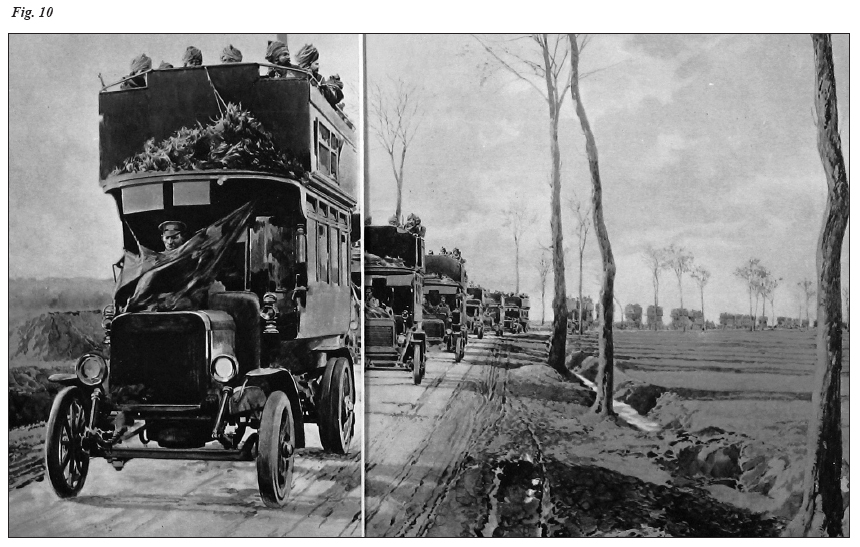
Display large image of Figure 10
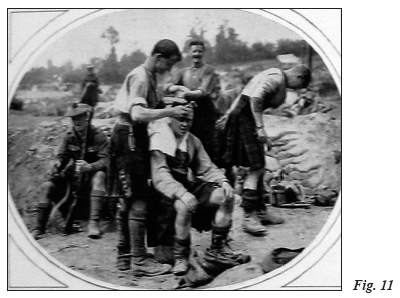
Display large image of Figure 11
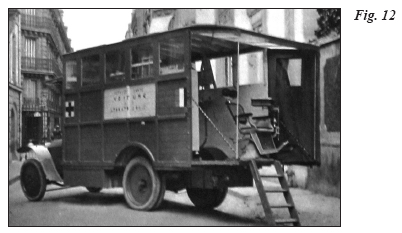
Display large image of Figure 12
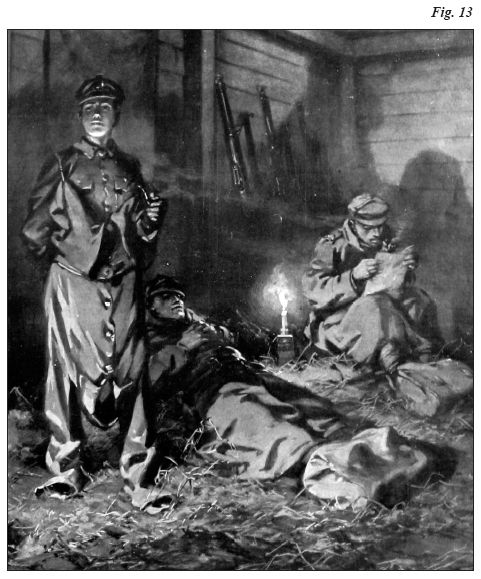
Display large image of Figure 13
15 A third broad category of illustration that helped span the gulf between civilian life and active military service explained “how a soldier did this” or “did that.” Photographs in the regular column, Science Jottings, (ILN, 22 January 1916) explained how the French Army managed its soldiers’ oral hygiene. Troops stationed in front line areas visited the Voitures de Stomatologie, cargo vans outfitted with a complete dental surgery (Fig. 12). How did British soldiers keep warm in their draughty farm billets in France and Belgium? They improvised, pulling the sleeves of their overcoats up over their legs and sleeping with their feet tucked into knapsacks (Fig. 13), according to the April 29, 1916, issue. Among the European combat fronts, perhaps none was more inhospitable than the Austro-Italian Alps, where the battle zone was as likely to be vertical as horizontal. Photographs and illustrations of soldiers climbing steep grades with heavy equipment were common, but ILN also showed men coming the other way. A March 4, 1916 illustration explains how the Italian forces evacuated casualties from high peaks by slinging stretchers from long cables. According to the caption writer, it was as though a little technical ingenuity could overcome nearly any challenge, no matter how insurmountable it might seem (Fig.14).
Bridging Time and Space: Trophies, Artifacts and Relics
16 Military impedimenta of all shapes and sizes served as war trophies and mementos for soldiers and civilians alike during the First World War. It is not surprising then, that the trophy theme recurs throughout wartime issues of ILN. A solemn, yet intricately detailed sketch from the issue of April 22, 1916, shows a French chasseur alpin making a votive offering of captured German gear to a statue of Joan of Arc (Fig.15).6 The Mauser rifle, bayonet and leather helmet are perfectly detailed. Fuse caps from shrapnel shells litter the floor around the soldier’s feet in the ruined church. Again, the drawing’s caption looks to the past, reminding British Protestant readers that votive offerings had been the norm among the French, Belgians, Dutch and Italians for many centuries. Although the caption for this image dismisses the superstitious practice of votive offerings as a Catholic tradition, scholars have shown that spiritualism and superstitious beliefs were common among soldiers of all Christian denominations, in part because the rational Christianity of the late-19th and early-20th centuries did not offer useful coping mechanisms to ordinary men in combat (Schweitzer 2003: 47).
Fig. 14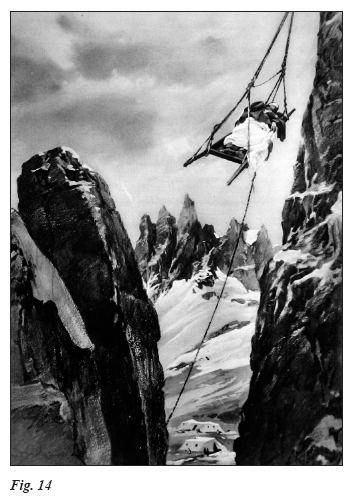
Display large image of Figure 14
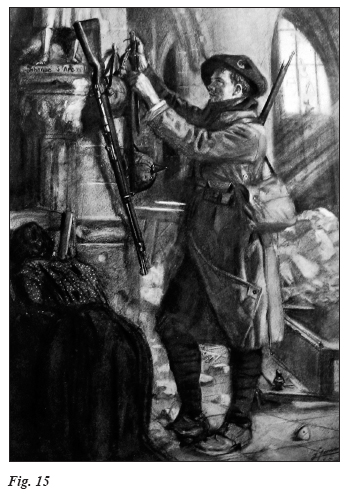
Display large image of Figure 15
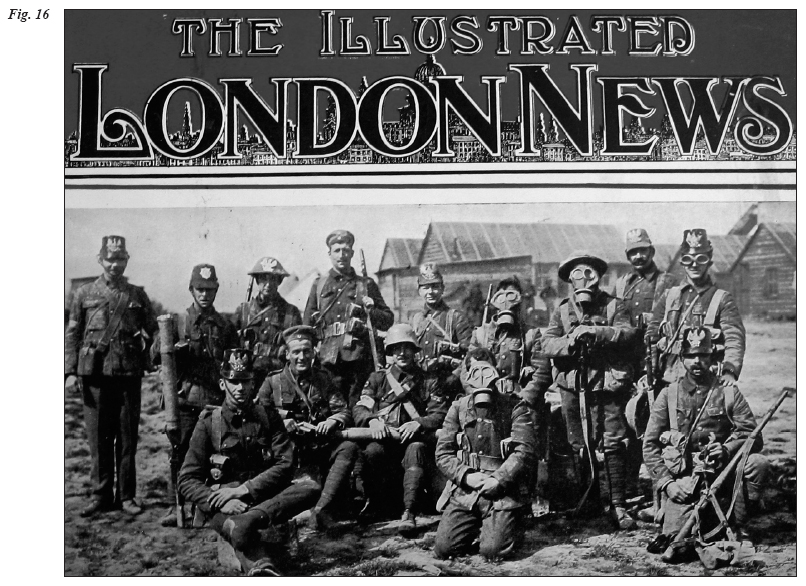
Display large image of Figure 16
17 Other less reverent trophy illustrations had little to do with appeasing saints. A photograph that appeared on the May 27, 1916, cover depicts a gang of British troops showing off their spoils: the Model 1916 Stahlhelm, older-style shako helmets of the Landwehr, respirators and soft caps (Fig. 16). As seen in the August 12, 1916, issue, a more unusual trophy captured from the Germans on the Somme in 1916 was a telescopic pole with a trench periscope mounted on top (Fig. 17). This device permitted artillery observers to scan no-man’s-land and enemy lines from the safety of their gun positions. The French employed a similar device with their Schneider gun trains in 1914.7 Numerous other examples of trophy collecting can be found in the pages of The Illustrated London News; in at least one case German prisoners performing a bizarre dance routine served as the ultimate war trophies for their British captors (Fig.18).8
Fig. 17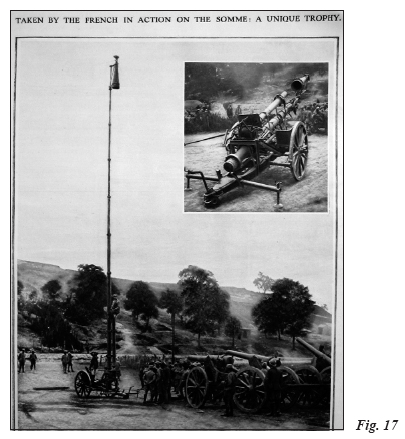
Display large image of Figure 17
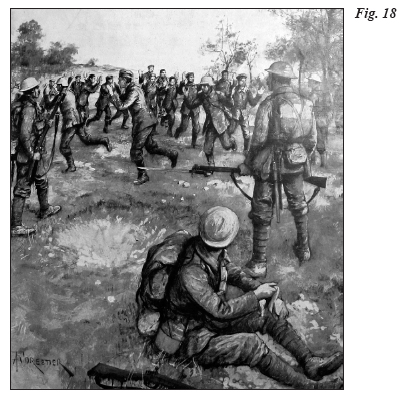
Display large image of Figure 18
18 There are numerous explanations for the appeal of military objects as trophies. When presented as a votive offering to Joan of Arc, for example, captured weapons and equipment functioned as tribute, but they also linked contemporary trials with past tribulation and triumph. A souvenir or trophy sent to a loved one might function as an unintentional memorial for a soldier who failed to return home (Saunders 2003: 24). For many soldiers, the battlefield trophy probably served as a keepsake for years to come. This explains the broad popularity of trench art during, and immediately after, the war. Ultimately, the war trophy—whatever its form—was a symbol of victory, in common with conventional trophies awarded to winners of a sporting match. In this respect, war trophies illustrated in ILN suggest yet another parallel with pre-war civilian norms.
The Mother of Invention: Innovation and Progress
19 The illustrators and caption-writers of The Illustrated London News mediated and interpreted the war experience for readers at home, often citing an ill-defined past as a frame of reference for the present. In this regard, the paper can be analyzed as a discursive vehicle, along the lines advocated by B.E. Maidment. But does this mean that images cannot also function as snapshots of the Great War period for researchers looking back with ninety years of hindsight? The illustrations do, indeed, reveal much about how soldiers employed technology and solved problems on the battlefield. For instance, the first tank illustrations to appear in November and December 1916 remind us of a parallel military development, the employment of protective paint schemes, the camouflage patterns employed on vehicles, heavy guns, aircraft and ships. Illustrations from ILN preserve a variety of camouflage techniques for differing applications. A two-page feature on the Portuguese Army in the December 23, 1916, issue shows a field gun and ammunition limber concealed with bundles of tree branches (Fig. 19). From the Italian front, a panoramic drawing depicting long screens suspended from wires stretched across a roadway, to shield troops and vehicles from enemy observers and pilots is rendered on August 26, 1916 (Fig. 20). In a two-page illustration from September 18, 1915, French troops are building screens to protect a railway line; the men use peculiar-looking ball-shaped hammers to drive mounting-stakes into the ground (Fig. 21). Indeed, some of the most innovative practitioners of camouflage were found in the French Army. Eugene Corbin, a French artillery reservist called up for service upon the outbreak of war, was horrified to learn that a fellow gunner was killed when his battery position was easily spotted and bombed by an enemy aircraft during the fighting of September 1914. Corbin called upon Louis Guingot, an artist and theatrical set decorator, to design large cloth screens painted with drab disruptive patterns. The French Army soon formed La Section de camouflage; at Guingot’s suggestion the new organization adopted a chameleon emblem as its insignia (Brunel 2005: 55-63). Guingot and Corbin were among the first to devise camouflage outfits for soldiers, usually consisting of overalls and a large hood in a range of drab colours. An Italian mountain sentry wears a similar suit—in white—in an illustration of January 8, 1916 (Fig. 22). Invisibility was an even better, if more elusive, alternative to camouflage and concealment, something that was apparently attempted by the French in the air war. On January 15, 1916, we find an illustration of a French aircraft with wings covered in transparent mica material, instead of the usual canvas cloth. According to the caption, the machine appeared as little more than a blur at 3,000 feet and was practically invisible at 6,000 (Fig. 23).
Fig. 19
Display large image of Figure 19

Display large image of Figure 20
20 Illustrations reveal that the Germans were no less adept at the art of concealment than their Allied counterparts. A two-page illustration printed in the aftermath of the 1916 Easter Rebellion shows soldiers of the Munster Fusiliers charging a German parapet, smashing small placards bearing anti-British propaganda (Fig. 24).9 What is especially interesting about this June 3, 1916, image is the clever hinged door that covered the embrasure of a German machine gun emplacement. When closed, the gun position would be invisible along the parapet; when the door was lowered by means of two cables, the gun could release an arc of fire against unsuspecting attackers. In this instance, evidently, the Irishmen were on top of the German trench before the gun found its marks.
21 In trench warfare, safe movement about the front line area was an obvious challenge; any man who made himself visible above ground was liable to observation by an enemy sniper or artillery spotter. The trench periscope was a basic tool for observers and sentries on all parts of the front. Various types of hand-held periscopes are in many illustrations and, as the war progressed, such devices were added to the list of products manufacturers and merchants advertised in ILN. W. Watson and Sons, self-described official opticians for His Majesty’s Government, offered the Watson’s Giraffe periscope for “8/6” plus postage to France (Fig. 25). According to the advertisement, the Giraffe permitted a soldier “to see obstructions 18 inches higher than his eyes” (15 January 1916), without distorting the view across no-man’s-land. Even when shown in advertisements—as opposed to war illustrations—such devices reminded readers that technology enhanced soldiers’ combat capabilities while ensuring their safety at the same time.
Fig. 21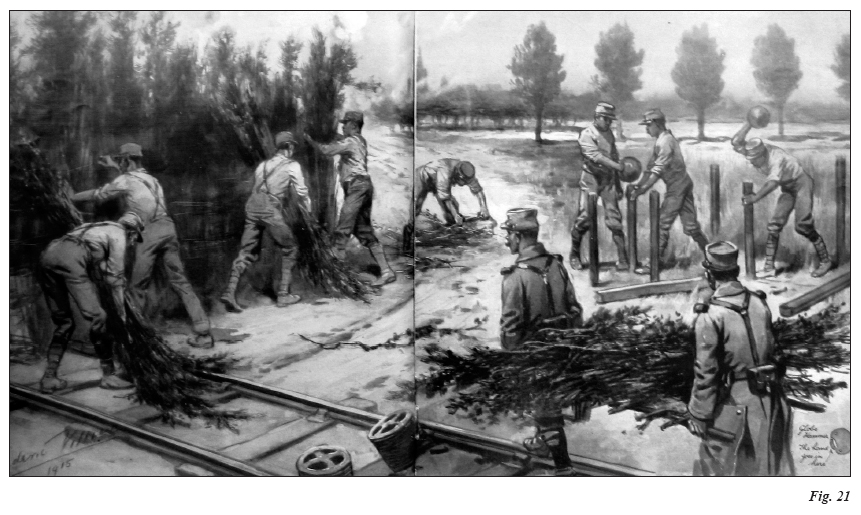
Display large image of Figure 21
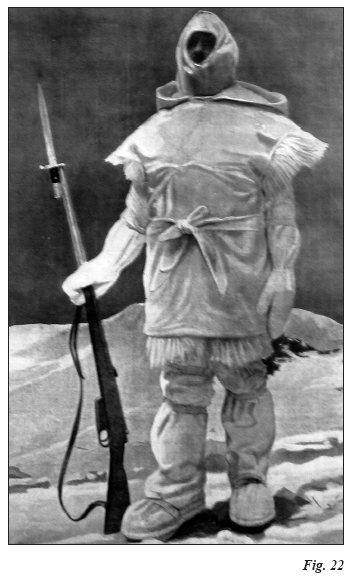
Display large image of Figure 22
22 After initial experiments on the Eastern Front, the German Army launched its first major gas attack north of Ypres, Belgium, in April 1915. The Allied press—including ILN—cried foul, but the gas race was on, with both sides developing evermore deadly chemical agents and sophisticated protective measures.10 Scenes of life and combat in a gas-drenched environment were popular subjects for illustrators. A sketch from January 1916 shows a section of British soldiers pushing a supply wagon forward, with their sergeant leading the way (Fig. 26). All of the men wear gas helmets as they pass through a zone “rendered unhealthy” by enemy gas. According to the soldier who prepared the sketch, this noctural scene was “ weird and wonderful…” (ILN, 22 January 1916). Another image of British troops (28 October 1916), this time a sketch from the Salonika front, shows a motorcycle dispatch rider in short sleeves reading a map with another man. Both wear gas helmets under their steel helmets, as protection against “Bulgar” gas shells (Fig. 27). The drawing is a perfect example of soldiers using new technology to adapt to an environment that other new technology had rendered inhospitable.
Fig. 23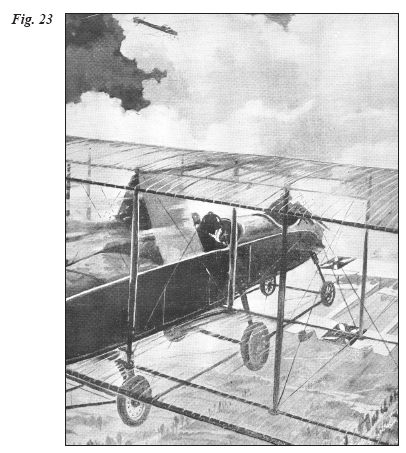
Display large image of Figure 23
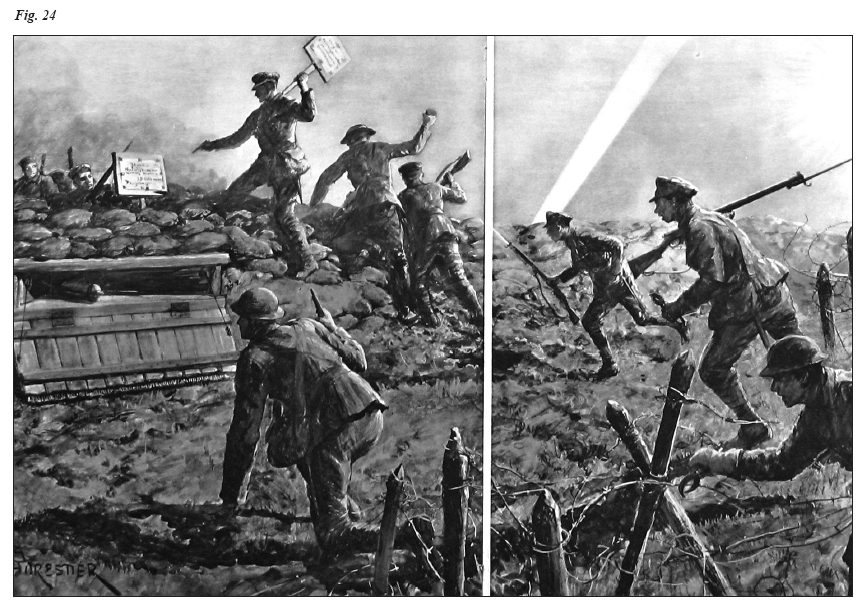
Display large image of Figure 24
23 Operational military historians have described the battlefields of the First World War as three-dimensional combat environments (Bailey 1996). In contrast with 18th- and early 19th-century warfare, the fighting of 1914-1918 was no longer linear, but featured heavy volumes of indirect artillery fire along with expanding operations in the air. In illustrations and photographs we find much evidence of this three-dimensional character, even in the earliest wartime issues of ILN. An illustration from September 26, 1914, shows a French aircraft getting airborne in the nick of time as German troops rush the landing strip (Fig. 28). That same year, the December 19 issue featured a complex illustration depicting a German air attack against French observation balloons, as well as the role of motorized transport on the ground (Fig. 29). Along with air warfare came fleets of truck-mounted and towed anti-aircraft guns in all armies.11 What goes up must come down, so it was not unusual to see the occasional parachutist, typically descending from a damaged observation balloon as illustrated on December 9, 1916 (Fig 30).
Fig. 25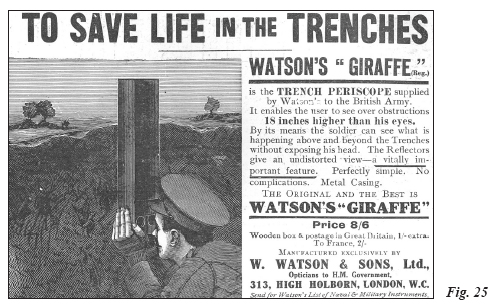
Display large image of Figure 25
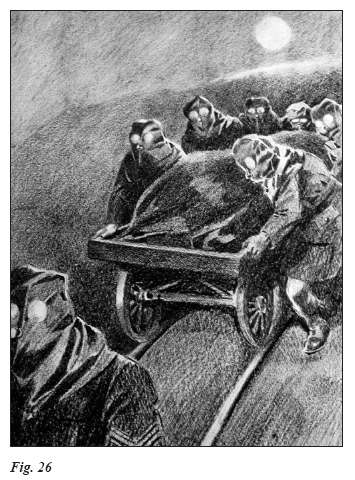
Display large image of Figure 26

Display large image of Figure 27
24 A requirement for long-range communications accompanied the advent of the three-dimensional battlefield. Although the technology was never quite satisfactory, soldiers commonly used telephone sets and, to a lesser degree, wireless technology to transmit orders and report information.12 When modern equipment failed, animals served as reliable back-ups. The regular column, Science Jottings (28 October 1916), included an image of carrier pigeons being transported in mobile lofts (Fig. 31)—they were surprisingly dependable. But if pigeons could be trusted to find their way across the battlefield, it was not as easy for soldiers to navigate through a maze of defensive positions, particularly at night when one trench looked much like any other. In 1915, French soldiers found an easy way to negotiate wooded areas leading to their trenches. A cord was strung along the correct path, and every few feet an empty wine bottle was attached. If the trail was lost in the darkness, a man simply had to feel his way forward to the next bottle (Fig. 32) as depicted on May 15, 1915.
Fig. 28
Display large image of Figure 28
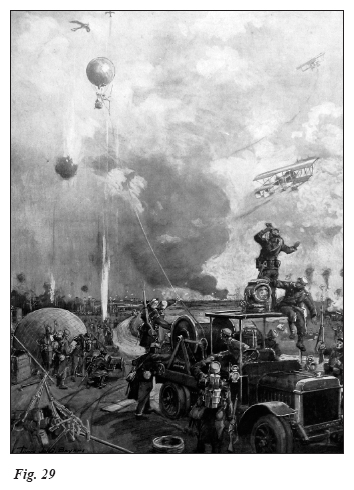
Display large image of Figure 29

Display large image of Figure 30
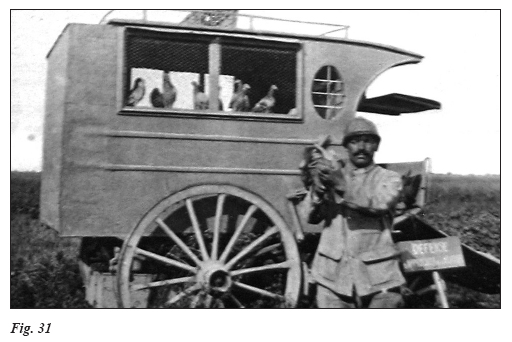
Display large image of Figure 31
25 Not all innovation or improvisation involved the latest technology and machinery. Particularly on strategically or geographically peripheral fronts, soldiers made do with fewer material resources and less equipment than the better supplied divisions, corps and armies on the Western Front. An excellent example from the campaign around Mount Kilimanjaro in German East Africa appears in July 1916. A British horse artillery battery is on the move, in pursuit of German troops. One of the wheels on the carriage of a thirteen-pounder gun has been damaged and replaced by a tree trunk (Fig. 33) “after the manner used in a local type of ambulance in the Balkans…” (1 July 1916). In the remote African theatre of war, it was likely that a replacement wheel was not immediately available.
Fig. 32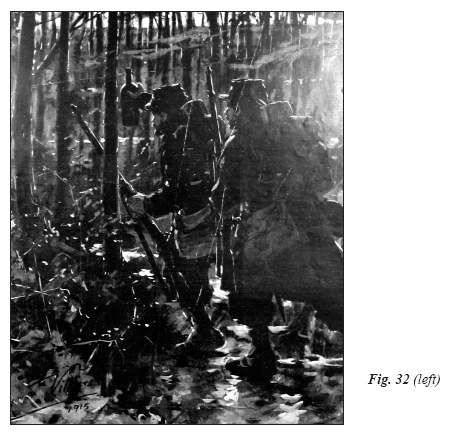
Display large image of Figure 32
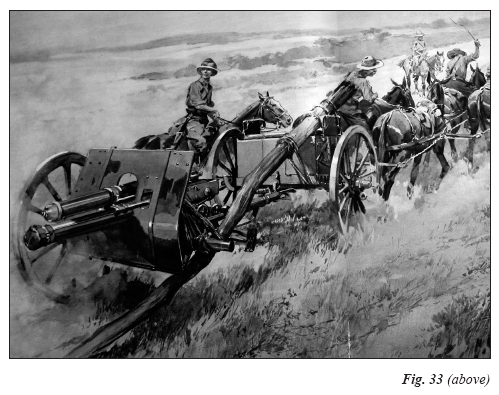
Display large image of Figure 33
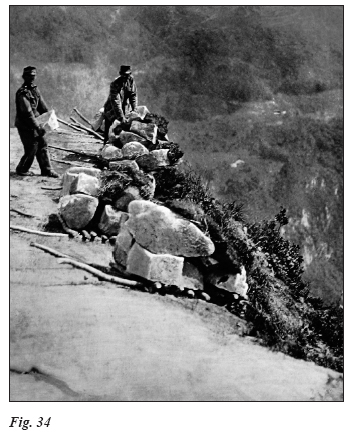
Display large image of Figure 34
26 With imposing mountain terrain and great vertical distances to conquer along the Isonzo River, the Austro-Italian front was a frequent source of inspiration for illustrations. In winter especially, it was a battle simply to exist on this ground, let alone engage the enemy. Soldiers and pack animals hauled every artillery shell, gun and supply up steep slopes to the front lines. As might be expected under such circumstances, supplies were perhaps not always as forthcoming as commanders may have wished. As such, a photograph from 1915 shows Austrian soldiers employing a very primitive technique to bombard their Italian enemies: logs apparently are used as levers to push large boulders off a cliff onto Italian positions below (Fig. 34). The heading above the photo reads: “Recalling Hannibal’s Passing of the Alps: Natural Munitions…” (11 September 1915). Again, invention and innovation in this modern war reflected a distant past.
Conclusion
27 Issues of The Illustrated London News published during the early years of the Great War represent a vast collection of vignettes showing the uses of objects—from wine bottles to boulders to parachutes—in the evolving struggle. This technological evolution was the very essence of forward-looking weekly content; yet, intentionally or not, editors, caption writers and artists seem to have grounded the paper’s images and text in a sometimes hazy, often imagined past, possibly establishing a link of shared experience between civilians and soldiers. Although we tend to remember the war as an overwhelmingly transformative experience, one that wrenched soldiers from everything familiar, the generation of 1914-1918 looked over its shoulder into the past as it marched into the age of Modernity.
References
Audoin-Rouzeau, Stéphane and Annette Becker. 2002. Understanding the Great War New York: Hill and Wang.
Bailey, Jonathan. 1996. The First World War and the Birth of the Modern Style of Warfare. Camberley Strategic and Combat Studies Unit Occasional Paper 22. Chamberley, England: British Staff College.
Brunel, Gaëton. 2005. Eugene Corbin, L’Inventeur du Camouflage en France. Militaria 242 (September): 55-63.
Campbell, David. 2007. A Forgotten Victory, Courcelette, 15 September 1916. Canadian Military History 16 (Spring): 27-48.
Habeck, Mary R. 2000. Technology in the First World War: The View from Below. In The Great War and the Twentieth Century, ed. Jay Winter et al, 110-11. New Haven: Yale University Press.
Hogart, Paul. 1967. The Artist as Reporter. New York: Studio Vista/Reinhold.
Jones, Barbara and Bill Howell. 1972. Popular Arts of the First World War. New York: McGraw-Hill.
Maidment, B. E. 1996. Reading Popular Prints, 1790-1870. Manchester: Manchester University Press.
Martin, Michèle. 2006. Images at War: Illustrated Periodicals and Constructed Nations. Toronto: University of Toronto Press.
Rawling, Bill. 1994. Communications in the Canadian Corps: Wartime Technological Progress Revisited. Canadian Military History 3 (Autumn): 6-21.
Saunders, Nicholas J. 2003. Trench Art: Materialities and Memories of War. Oxford: Berg.
Schweitzer, Richard. 2003. The Cross and the Trenches: Religious Faith and Doubt among British and American Great War Soldiers. Westport: Praeger.
Sinnema, Peter W. 1998. Dynamics of the Pictured Page: Representing the Nation in the Illustrated London News. Aldershot: Ashgate.
Wright, Patrick. 2000. Tank: The Progress of a Monstrous War Machine. New York: Viking.
Notes